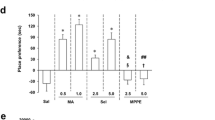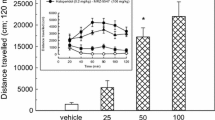Abstract
The neuroprotective effects of riluzole (2-amino-6-trifluoromethoxy benzothiazole), a Na+ channel blocker with antiglutamatergic activity, MK-801, a blocker of N-methyl-D-aspartate (NMDA) receptors and monoamine oxidase (MAO) inhibitor pargyline were compared in the model of 1-methyl-4-phenyl-1,2,3,6-tetrahydropyridine (MPTP)-induced depletion of dopamine and its metabolite 3, 4-dihydroxyphenylacetic acid (DOPAC) levels in mice. The mice received four intraperitoneal injections of MPTP (10 mg/kg) at 1-hr intervals and then the brains were analyzed at 1, 3 and 7 days after the treatments. Dopamine and DOPAC levels were significantly decreased in the striatum from 1 day after MPTP treatments. A severe depletion in dopamine and DOPAC levels was found in the striatum 3 and 7 days after MPTP treatments. Riluzole dose-dependently antagonized the MPTP-induced decrease in dopamine and DOPAC levels in the striatum. Pargyline also protected against MPTP-induced decrease in dopamine levels in the striatum. However, this drug showed no significant change in the striatal DOPAC levels. On the other hand, MK-801 failed to protect against MPTP-induced decrease in dopamine levels in the striatum. However, MK-801 reversed the MPTP-induced decrease in DOPAC levels. These results suggest that riluzole can protect against MPTP-induced striatal dopamine and DOPAC depletion in mice. This protective effect may be caused by inactivation of voltage-dependent Na+ channels by riluzole. Furthermore, the present study suggests that the activation of NMDA receptors does not mainly contribute to MPTP-induced neurodegeneration, whereas MAO, especially MAO type B(MAO-B) plays a crucial role in MPTP-induced degeneration of the nigrostriatal dopaminergic neuronal pathway.
Similar content being viewed by others
REFERENCES
Barnéoud, P., Mazadier, M., Miquet, J.M., Parmentier, S., Dubédat, P., Doble, A., and Borireau, A. (1996). Neuroprotective effects of riluzole on a model of Parkinson's disease in the rat. Neuroscience 74:971-983.
Benavides, J., Camelin, J.C., Mitrani, N., Flamand, F., Uzan, A., Legrand, J.J. Gueremy, C., and Le Fur. G. (1985). 2-Amino-6-trifluoromethoxy benzothiazole, a possible antagonist of excitatory amino acid neurotransmission II. Biochemical properties. Neuropharmacology 24:1085-1092.
Benazzouz, A., Boraud, T., Dubédat, P., Boireau, A., Stutzmann, J.M., and Gross, C (1995). Riluzole prevents MPTP-induced parkinsonism in the rhesus monkey: a preliminary study. Eur. J. Pharmacol. 284:299-307.
Bensimon, G., Lacomblez, L., and Meininger, V. (1994). The ALS/Riluzole Study Group. A controlled trial of riluzole in amyotrophic lateral sclrosis. New Engl. J. Med. 330:585-601.
Bezard, E., Stutzmann, J.M., Imbert, C., Boraud, T., Boireau, A., and Gross, C.E. (1998). Riluzole delayed appearance of parkinsonian motor abnormalities in a chronic MPTP monkey model. Eur. J. Pharmacol. 356: 101-104.
Boireau, A., Dubédat, P., Bordier, F., Peny, C., Miquet, J.M., Durand, G., Meunier, M., and Doble, A. (1994a). Riluzole and experimental parkinsonism: antagonism of MPTP-induced decrease in central dopamine levels in mice. NeuroReport 5:2657-2660.
Boireau, A., Miquet, J.M., Dubédat, P., Meunier, M., and Doble, A. (1994b). Riluzole and experimetal parkinsonism: partial antagonism of MPP+-induced increase in striatal extracellular dopamine in rats in vivo. NeuroReport 5:2157-2160.
Gluck, M.R., Krueger, M.J., Ramsey, R.R., Sabin, S.O., Singer, T.P., and Nicklas, W.J. (1994). Characteraization of the inhibitory mechanism of 1-methyl-4-phenylpyridinium and 4-phenylpyridine analogs in inner membrance preparation. J. Biol. Chem. 269:3167-3174.
Heikkila, R.E., Manzino, L., Cabbat, F.S., and Duvoisin, R.C. (1984). Protection against the dopaminergie neurotoxicity of 1-methyl-4-phenyl-1,2,5,6-tetrahydropyridine by monoamine oxidase inhibitors. Nature 311:467-469.
Jones-Humble, S.A., Morgan, P.F., and Cooper, B.R. (1994). The novel anticonvulsant lamotrigine prevents dopamine depletion in C57 black mice in the MPTP animal model of Parkinson's disease. Life Sci 54:245-252.
Kupsch, A., Löschmann, P.A., Sauer, H., Arnold, G., Renner, P., Pufal, D., Burg, M., Wachtel, H., Bruggencate, G., and Oertel, W.H. (1992). Do NMDA receptor antagonists protect against MPTP-toxicity? Biochemical and immunochemical analyses in black mice. Brain Res. 592:74-83.
Markey, S.P., Johannessen, J.N., Chiueh, C.C., Burns, R.S., and Herkenham, M.A., (1984). Intraneuronal generation of a pyridinium metabolite may cause drug-induced parkinsonism. Nature 311:464-467.
Nicklas, W.J., Vyas, I., and Heikkila, R.E. (1985). Inhibition of NADH-linked oxidation in brain mitochondria by 1-methyl-4-phenyl-1,2,3,6-tetrahydropyridine, a metabolite of the neurotoxin, 1-methyl-4-phenyl-1,2,3,6-tetrahydropyridine. Life Sci. 36:2503-2508.
Olney, J.W., 1989. Excitatory amino acids and neuropsychiatric disorders. Biol. Psychiatr. 26:505-525.
Przedborski, S., Jackson-Lewis, V., Yokoyama R., Shibata, T., Dawson, V.L., and Dawson, T.D. (1996). Role of neuronal nitric oxide in 1-methyl-4-phenyl-1,2,3,6-tetrahydropyridine (MPTP)-induced dopaminergic neurotoxicity. Proc. Natl. Acad. Sci. USA. 93:4565-4571.
Sonsalla, P.K., Zeevalk, G.D., Manzino, L., Giovanni, A., and Nicklas, W.J. (1992). MK-801 fails to protect against the dopaminergic neuropathology produced by systemic 1-methyl-4-phenyl-1,2,3,6-tetrahydropyridine in mice or intranigral 1-methyl-4-phenylpyridinium in rats. J. Neurochem. 58:1979-1982.
Storey, E., Hyman, B.T., Jenkins, B., Brouillet, E., Miller, J.M., Rosen, B.R., and Beal, M.F. (1992). MPP+ produces excitotoxic lesions in rat striatum due to impairment of oxidative metabolism. J. Neurochem. 58:1975-1978.
Tanji, H., Araki, T., Nagasawa, H., and Itoyama, Y. (1999). Differential vulnerability of dopamine receptors in the mouse brain treated with MPTP. Brain Res. 824:224-231.
Turski, L., Bressler, K., Rettig, K.J., Löschmann, P.A., and Wachtel, H. (1991). Protection of substantia nigra from MPP+ neurotoxicity by N-methyl-D-aspartate antagonists, Nature 349:414-418.
Author information
Authors and Affiliations
Rights and permissions
About this article
Cite this article
Araki, T., Kumagai, T., Matsubara, M. et al. Protective Effect of Riluzole on MPTP-Induced Depletion of Dopamine and Its Metabolite Content in Mice. Metab Brain Dis 15, 193–201 (2000). https://doi.org/10.1023/A:1011111708901
Issue Date:
DOI: https://doi.org/10.1023/A:1011111708901




